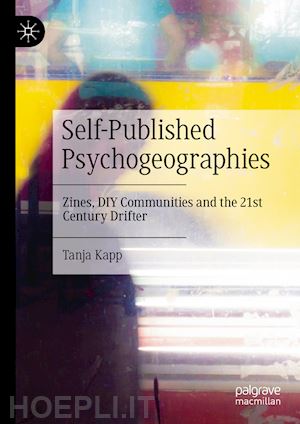

Questo prodotto usufruisce delle SPEDIZIONI GRATIS
selezionando l'opzione Corriere Veloce in fase di ordine.
Pagabile anche con Carta della cultura giovani e del merito, 18App Bonus Cultura e Carta del Docente
This book explores the world of psychogeographical walking as portrayed in zines – self-made, low-budget publications circulated within DIY communities. Termed "new psychogeography", the representation of these mobilities in zines challenge conventional dualisms, favoring peripheral spaces and polyphonic perspectives over urban-centric voyeurism. Through four case studies, the book explores the evolution of the contemporary drifter, emphasizing a departure from conquering cityspaces through stalking to exploring how spaces shape memory, experience, and notions of home. Pioneering research at the intersection of zine and travel writing studies, it unveils the psychogeographical mediality inherent to this medium.
Chapter 1: Introduction: New Selves Embarking upon Old Paths.- Part I: Psychogeography and Self-Published Media.- Chapter 2: Tendency to Trespass: Walking and Publishing in the History of Psychogeography.- Chapter 3: Affinity to Assemble: Zines as Walking Travelogues.- Part II: Case Studies.- Chapter 4: Oliver East’s Trains Are … Mint: Walking Train Tracks.- Chapter 5: Simon Moreton’s Where?: Blurring Disparate Perspectives.- Chapter 6: Loosing, Departing: Trauma and Temporality in Peony Gent’s Visual Poetry.- Chapter 7: Divergent Readings and Synaesthesia in Olivia Sullivan’s Zines.- Chapter 8: Conclusion: Characteristics of the Zine’s Psychogeographical Mediality.
Tanja Kapp is Assistant Lecturer in the English Department of the University of Tübingen, Germany. Previously, she was a Research Fellow and Doctoral Candidate at the Graduate Research Group ‘New Travel – New Media’ at the University of Freiburg, Germany, where she received her PhD in English Literature.











Il sito utilizza cookie ed altri strumenti di tracciamento che raccolgono informazioni dal dispositivo dell’utente. Oltre ai cookie tecnici ed analitici aggregati, strettamente necessari per il funzionamento di questo sito web, previo consenso dell’utente possono essere installati cookie di profilazione e marketing e cookie dei social media. Cliccando su “Accetto tutti i cookie” saranno attivate tutte le categorie di cookie. Per accettare solo deterninate categorie di cookie, cliccare invece su “Impostazioni cookie”. Chiudendo il banner o continuando a navigare saranno installati solo cookie tecnici. Per maggiori dettagli, consultare la Cookie Policy.